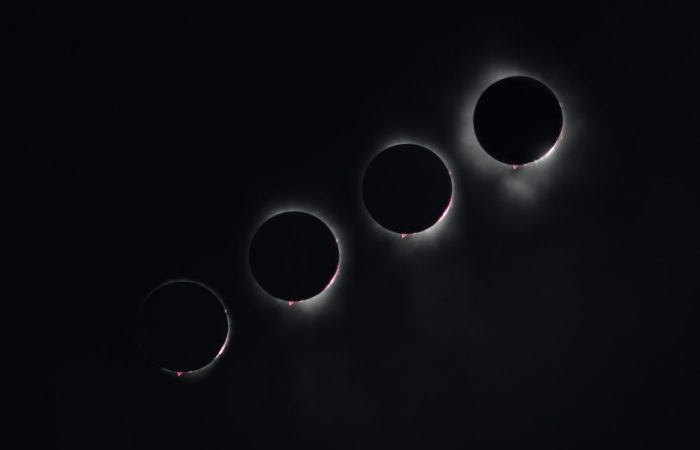
Tracking the Solar Eclipse
Observing a solar eclipse requires precise planning and tracking, and having the right software is essential. Here are some of the best programs and apps to enhance your solar eclipse experience:
Solar Eclipse Timer
- Features: Real-time notifications, countdown timer, GPS-based predictions
- Why It’s Great: This app provides accurate timing information and helps you not miss any crucial phases of the solar eclipse.
NASA’s Eyes
- Features: Interactive 3D visualizations, data from NASA missions, real-time updates
- Why It’s Great: This software offers comprehensive information and interactive experiences to enhance understanding and observation of the solar eclipse.
Stellarium
- Features: Virtual planetarium, realistic sky views, detailed eclipse data
- Why It’s Great: Stellarium allows you to simulate future solar eclipses and provides accurate observation information.
Eclipse Safari
- Features: Live updates, interactive maps, scientific explanations
- Why It’s Great: This app provides a comprehensive overview of the solar eclipse with many useful features for amateur astronomers.
With these software solutions, you’ll be well-equipped to precisely track the next solar eclipse and fully enjoy the event.
This table provides the time that totality began in some U.S. cities in the path of totality. These areas also experienced a partial eclipse before and after these times.
| Location | Partial Begins | Totality Begins | Maximum | Totality Ends | Partial Ends |
|---|---|---|---|---|---|
| Dallas, Texas | 12:23 p.m. CDT | 1:40 p.m. CDT | 1:42 p.m. CDT | 1:44 p.m. CDT | 3:02 p.m. CDT |
| Idabel, Oklahoma | 12:28 p.m. CDT | 1:45 p.m. CDT | 1:47 p.m. CDT | 1:49 p.m. CDT | 3:06 p.m. CDT |
| Little Rock, Arkansas | 12:33 p.m. CDT | 1:51 p.m. CDT | 1:52 p.m. CDT | 1:54 p.m. CDT | 3:11 p.m. CDT |
| Poplar Bluff, Missouri | 12:39 p.m. CDT | 1:56 p.m. CDT | 1:56 p.m. CDT | 2:00 p.m. CDT | 3:15 p.m. CDT |
| Paducah, Kentucky | 12:42 p.m. CDT | 2:00 p.m. CDT | 2:01 p.m. CDT | 2:02 p.m. CDT | 3:18 p.m. CDT |
| Carbondale, Illinois | 12:42 p.m. CDT | 1:59 p.m. CDT | 2:01 p.m. CDT | 2:03 p.m. CDT | 3:18 p.m. CDT |
| Evansville, Indiana | 12:45 p.m. CDT | 2:02 p.m. CDT | 2:04 p.m. CDT | 2:05 p.m. CDT | 3:20 p.m. CDT |
| Cleveland, Ohio | 1:59 p.m. EDT | 3:13 p.m. EDT | 3:15 p.m. EDT | 3:17 p.m. EDT | 4:29 p.m. EDT |
| Erie, Pennsylvania | 2:02 p.m. EDT | 3:16 p.m. EDT | 3:18 p.m. EDT | 3:20 p.m. EDT | 4:30 p.m. EDT |
| Buffalo, New York | 2:04 p.m. EDT | 3:18 p.m. EDT | 3:20 p.m. EDT | 3:22 p.m. EDT | 4:32 p.m. EDT |
| Burlington, Vermont | 2:14 p.m. EDT | 3:26 p.m. EDT | 3:27 p.m. EDT | 3:29 p.m. EDT | 4:37 p.m. EDT |
| Lancaster, New Hampshire | 2:16 p.m. EDT | 3:27 p.m. EDT | 3:29 p.m. EDT | 3:30 p.m. EDT | 4:38 p.m. EDT |
| Caribou, Maine | 2:22 p.m. EDT | 3:32 p.m. EDT | 3:33 p.m. EDT | 3:34 p.m. EDT | 4:40 p.m. EDT |

Recommended Aperture (f-number) and Exposure Time for Solar Eclipse Photography
Capturing the different phases of a solar eclipse requires adjusting your camera settings for optimal exposure. Here’s a small list of recommended aperture settings (f-numbers) and corresponding exposure times for various phases of a solar eclipse:
Partial Eclipse (Sun with Solar Filter)
- Aperture: f/8 to f/11
- Exposure Time: 1/1000 to 1/2500 seconds
-
Diamond Ring Effect
- Aperture: f/8 to f/11
- Exposure Time: 1/500 to 1/1000 seconds
-
Baily’s Beads
- Aperture: f/8 to f/11
- Exposure Time: 1/500 to 1/1000 seconds
-
Totality (Without Solar Filter)
- Aperture: f/2.8 to f/5.6
- Exposure Time: 1/2 to 2 seconds
-
Prominences
- Aperture: f/8 to f/11
- Exposure Time: 1/125 to 1/250 seconds
-
Corona
- Aperture: f/2.8 to f/5.6
- Exposure Time: 1/2 to 2 seconds
These settings serve as a starting point. Always check your camera’s histogram to ensure the image is correctly exposed and adjust settings accordingly. Remember to use a solar filter during all phases except totality to protect both your camera and your eyes.









